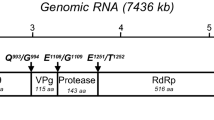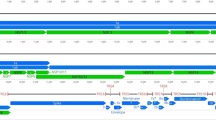Abstract
A novel goose calicivirus (GoCV) was sequenced. The 8013-nt-long genome was organized into two open reading frames that were in the same frame and separated by 3 nucleotides. This feature is similar to what has been observed in turkey calicivirus (TuCV). Comparison of GoCV with other caliciviruses showed that it shared the highest amino acid sequence identities of 62, 38, and 52 % in the nonstructural protein, VP1, and VP2, respectively, with TuCV. Phylogenetic analysis based on the amino acid sequences of nonstructural protein and VP1 demonstrated that GoCV was most closely related to but distinct from TuCV. Thus, GoCV was identified as a novel member in the proposed genus Nacovirus.


Similar content being viewed by others
References
Allander T, Tammi MT, Eriksson M, Bjerkner A, Tiveljung-Lindell A, Andersson B (2005) Cloning of a human parvovirus by molecular screening of respiratory tract samples. Proc Natl Acad Sci 102:12891–12896
Clarke IN, Estes MK, Green KY, Hansman GS, Knowles NJ, Koopmans MK, Matson DO, Meyers G, Neill JD, Radford A, Smith AW, Studdert MJ, Thiel H-J, Vinjé J (2012) Caliciviridae. In: King AMQ, Adams MJ, Carstens EB, Lefkowitz EJ (ed) Virus taxonomy. Classification and nomenclature of viruses. Ninth report of the International Committee on Taxonomy of Viruses. Elsevier, London, pp 977–986
Farkas T, Sestak K, Wei C, Jiang X (2008) Characterization of a rhesus monkey calicivirus representing a new genus of Caliciviridae. J Virol 82:5408–5416
Gough RE, Drury SE, Bygrave AC, Mechie SC (1992) Detection of caliciviruses from pheasants with enteritis. Vet Rec 131:290–291
Gough RE, Spackman D (1981) Virus-like particles associated with disease in guinea fowl. Vet Rec 109:497
Kapoor A, Victoria J, Simmonds P, Wang C, Shafer RW, Nims R, Nielsen O, Delwart E (2008) A highly divergent picornavirus in a marine mammal. J Virol 82:311–320
L’Homme Y, Sansregret R, Plante-Fortier E, Lamontagne AM, Ouardani M, Lacroix G, Simard C (2009) Genomic characterization of swine caliciviruses representing a new genus of Caliciviridae. Virus Genes 39:66–75
Meyers G, Wirblich C, Thiel HJ, Thumfart JO (2000) Rabbit hemorrhagic disease virus: genome organization and polyprotein processing of a calicivirus studied after transient expression of cDNA constructs. Virology 276:349–363
Ng TFF, Marine R, Wang C, Simmonds P, Kapusinszky B, Bodhidatta L, Oderinde BS, Wommack KE, Delwart E (2012) High variety of known and new RNA and DNA viruses of diverse origins in untreated sewage. J Virol 86:12161–12175
Oka T, Yamamoto M, Katayama K, Hansman GS, Ogawa S, Miyamura T, Takeda N (2006) Identification of the cleavage sites of sapovirus open reading frame 1 polyprotein. J Gen Virol 87(Pt 11):3329–3338
Poet SE, Skilling DE, Megyesl JL, Gilmartin WG, Smith AW (1996) Detection of a non-cultivatable calicivirus from the white tern (Gygis alba rothschildi). J Wildl Dis 32:461–467
Sauvage V, Ar Gouilh M, Cheval J, Muth E, Pariente K, Burguiere A, Caro V, Manuguerra JC, Eloit M (2012) A member of a new Picornaviridae genus is shed in pig feces. J Virol 86:10036–10046
Sironi G (1994) Concurrent calicivirus and Isospora lacazei infections in goldfinches (Carduelis carduelis). Vet Rec 134:196
Tamura K, Peterson D, Peterson N, Stecher G, Nei M, Kumar S (2011) MEGA5: molecular evolutionary genetics analysis using maximum likelihood, evolutionary distance, and maximum parsimony methods. Mol Biol Evol 28:2731–2739
Wolf S, Reetz J, Hoffmann K, Gründel A, Schwarz BA, Hänel I, Otto PH (2012) Discovery and genetic characterization of novel caliciviruses in German and Dutch poultry. Arch Virol 157:1499–1507
Wolf S, Reetz J, Otto P (2011) Genetic characterization of a novel calicivirus from a chicken. Arch Virol 156:1143–1150
Acknowledgments
This work was supported by the China Agriculture Research System (CARS-43) and the Special Fund for Agro-Scientific Research in the Public Interest (201003012).
Author information
Authors and Affiliations
Corresponding author
Additional information
The GenBank accession number for the study sequence is KJ473715.
Electronic supplementary material
Below is the link to the electronic supplementary material.
Rights and permissions
About this article
Cite this article
Liao, Q., Wang, X., Wang, D. et al. Complete genome sequence of a novel calicivirus from a goose. Arch Virol 159, 2529–2531 (2014). https://doi.org/10.1007/s00705-014-2083-6
Received:
Accepted:
Published:
Issue Date:
DOI: https://doi.org/10.1007/s00705-014-2083-6




